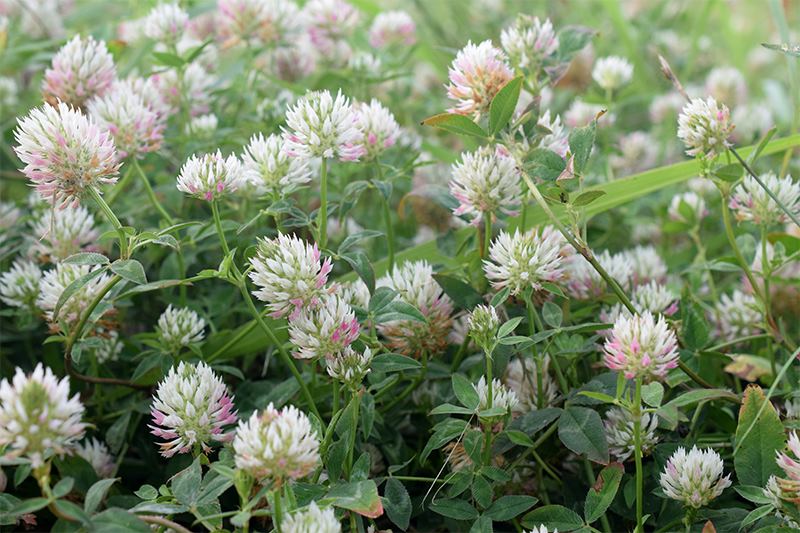Lablab-Lablab purpureus

By Kent Kammermeyer, Senior Wildlife Biologist
Originating in tropical Africa, Lablab also known as Hyacinth bean and Dolichos lablab is in the legume or bean family. It is an annual twining vine with purplish stems and alternate, pinnately divided leaves with three large leaflets. It has white, pink or purplish flowers in long clusters that are pea-shaped. Its fruit is a flat, curved maroon or purplish pod with three to five black seeds. It is one of a group of three (the others are cowpea and soybeans) highly preferred, grazing sensitive summer annual legumes commonly planted for deer in the U.S. Planted in large fields or protected by fence or repellent, lablab is drought resistant and highly productive at 2,000 to 6,000 lbs/acre production and 22 to 27% protein.
Adaptation/Establishment
It is quite drought tolerant when established, but it will not grow in wet soils. It is extremely tolerant of soil texture, growing in deep sands to heavy clays provided there is good drainage. It will grow in a wide range of pH from 5.0 to 7.5 but prefers a pH between 6.0 and 7.0. Plant lablab at 15-20 lbs/acre at a depth of one-half to one and one-half inches deep. Inoculate with cowpea strain of inoculant to encourage good root nodulation, which allows the plant to fix its own nitrogen (N) from the air. Failure to inoculate will cause poor growth on most soils. Fertilize with 300 lbs/acre of 0-20-20. Plant it in March in the Deep South and June in the North. As with soybeans, lablab planted early in the South will produce a mature bean in late summer if the deer grazing pressure allows it to flower and develop a pod and seed. Late-planted lablab in the North may not have time to reach maturity before frost but this is no great disadvantage because the value of this plant is in the vegetative forage provided by the leafy growth.
Varieties/Management
Lablab can be seeded in mixes very similar to soybeans. Thin the rate of lablab to 10lbs/acre and mix with 10 lbs/acre cowpeas, 10 lbs/acre corn, or five lbs/acre grain sorghum. This should produce a weed-free legume/grass mix which is highly compatible because of the ability of the lablab to produce over 200 lbs/acre N some of which is available for the grass to use for growth and seed production.
However, all of this discussion is frivolous if you cannot get this plant past the deer herd for at least 30-45 days without heavy grazing. Like soybeans, plant lablab in big fields (five to 10 acres or larger) or protect it with repellents or fencing. I am trying to convince you that it is generally a losing proposition to plant lablab in a small field with no protection! It will be overgrazed and killed out, thus defeating your purpose of providing high quality warm season grazing for an entire summer, especially late summer stress period and early fall bow hunting. Important note: if only the leaf is grazed (not the stem), it will provide two to three grazings of the same leaf stem over the course of an entire warm season. Cattlemen and shepherds recommend first grazing at 10 weeks from sowing and then remove animals to allow further leaves to develop. Deer managers should use a polytape electric fence (with peanut butter applied), repellent-soaked fencing such as that provided by Plot saver or repellent-soaked rope treated with products such as Deer Stopper, Hinder, Deer Away, Deer Off, Liquid Fence or other ammonia or egg-based smell and taste repellents. In addition, Milorganite organic fertilizer (a highly-treated product of the Milwaukee, WI sewage treatment facility) at 200-250 lbs/acre broadcast across the seedbed surface as the final operation after planting showed promising results for three to four weeks (depending on frequency of rainfall and deer density) in a University of Georgia study. The objective, of course, is to keep grazing pressure off of young, tender succulent seedlings until enough of a root system can be produced to withstand grazing pressure as the seedling matures (usually sometime between 30 and 60 days). Here again, early-planted stands established in April in most of the Southeast (when native growth in nearby woodlands is highly palatable and nutritious) will help keep deer out of your lablab patch until it is tough enough to take the pressure. Of course, this will also depend on the size of your deer herd. One with less than 20 deer/square mile will certainly be easier to maintain a lablab patch all summer than one with more than 40 deer/square mile.
In summary, lablab is an attractive, nutritious, high quality summer legume that is drought tolerant and will last until first frost well into bow season if planted in big fields or protected for the first 30-60 days. Pennington Seed Company sells lablab pre-inoculated in 10lb. bags, enough to plant ½ acre alone or 1 acre mixed with grain sorghum, corn or cowpeas.




